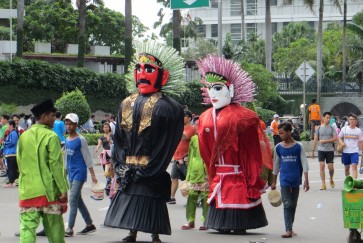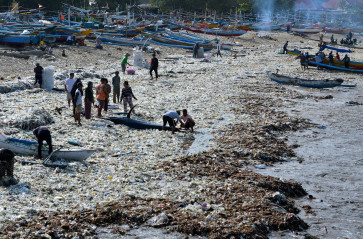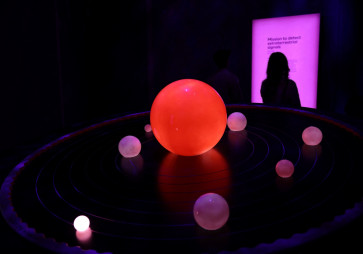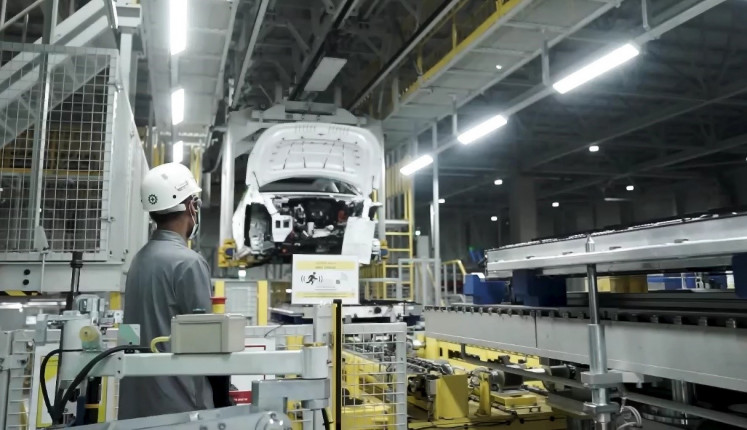Dutch Holocaust museum exhibits Jeroen Krabbe paintings
Change text size
Gift Premium Articles
to Anyone
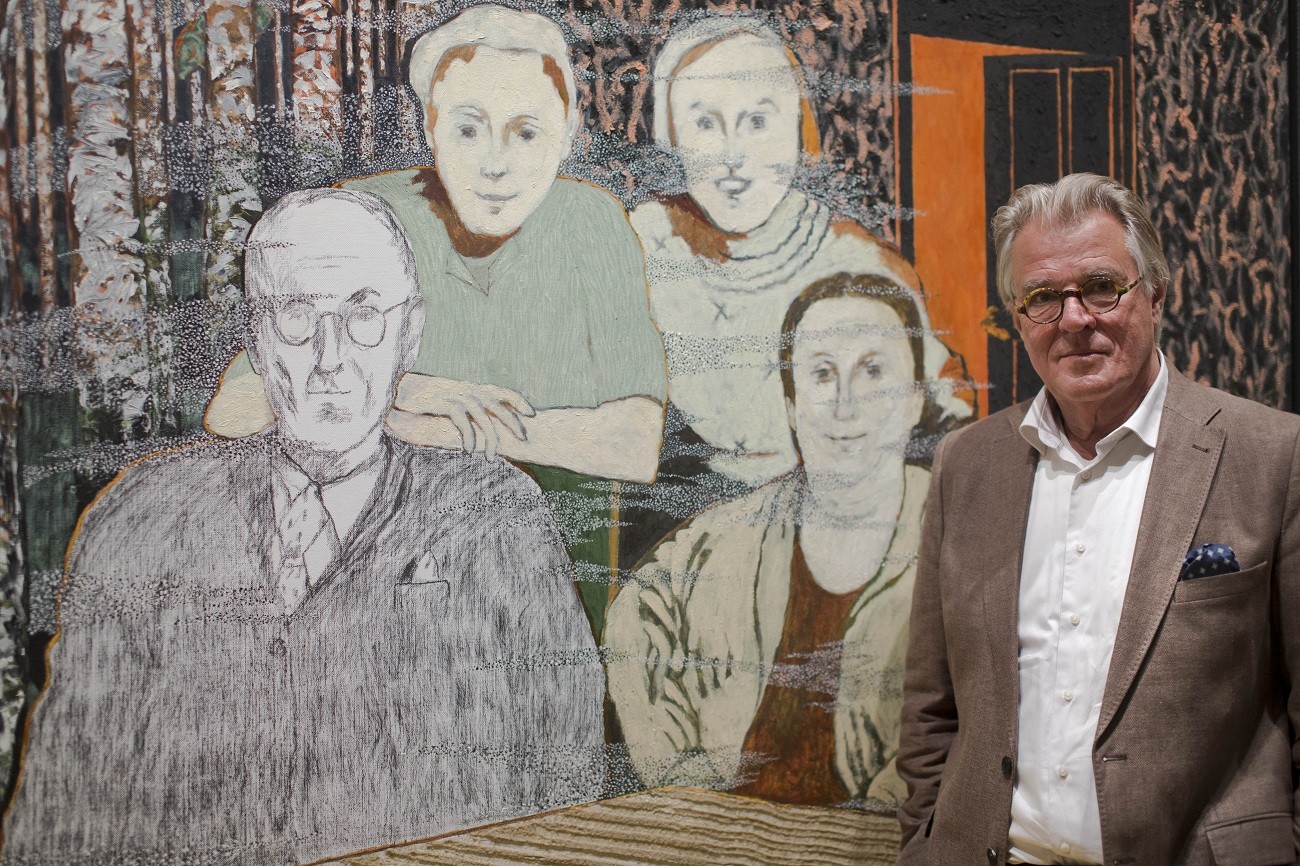 Dutch actor and artist Jeroen Krabbe poses in front of his painting which tells the story of his grandfather Abraham Reiss, left, who was murdered in the Sobibor Nazi German extermination camp, during a press preview at the National Holocaust Museum in Amsterdam, Netherlands, Thursday, May 12, 2016. More than 70 years after tens of thousands of Dutch Jews were deported and murdered by the Nazis, the Netherlands is finally getting a national Holocaust museum. (AP/Peter Dejong)
Dutch actor and artist Jeroen Krabbe poses in front of his painting which tells the story of his grandfather Abraham Reiss, left, who was murdered in the Sobibor Nazi German extermination camp, during a press preview at the National Holocaust Museum in Amsterdam, Netherlands, Thursday, May 12, 2016. More than 70 years after tens of thousands of Dutch Jews were deported and murdered by the Nazis, the Netherlands is finally getting a national Holocaust museum. (AP/Peter Dejong)
M
ore than 70 years after tens of thousands of Dutch Jews were deported and killed by the Nazis, the Netherlands is finally getting a national Holocaust museum.
It will be three years before the new museum is completed, but on Monday it opens its doors to host a harrowing exhibition of paintings by actor and artist Jeroen Krabbe.
The location of the museum, a former teacher training school in the heart of Amsterdam's old Jewish quarter, is a small but hugely significant ray of light in the dark history of Jews in the Dutch capital during World War II.
Some 600 Jewish children were spirited to safety via the school from a neighboring kindergarten where they were being held while awaiting deportation, said curator Annemiek Gringold. On the other side of the street stands the Hollandsche Schouwburg, a theater used by the Nazi occupiers as a gathering point for Jews who were rounded up — often with the help of Dutch collaborators paid a bounty for each person they betrayed — and transported to their deaths.
In all, 104,000 Dutch Jews were among the 6 million Jews murdered in the Holocaust. The theater is now home to a memorial to those victims. Nearby are also the Jewish Historical Museum and a 17th-century Portuguese Synagogue.
(Read also: 'Chaplin's World' honors cinema legend with first museum)
The nine paintings on show Monday are collectively titled "The Demise of Abraham Reiss." They trace the life of Krabbe's grandfather, who was murdered by the Nazis in 1943 in the Sobibor death camp in occupied Poland.
From a man sitting in a forest of birch trees on the edge of Amsterdam, the paintings trace Reiss' life in pre-war Amsterdam to his detention in the Westerbork camp in the northeastern Netherlands and his arrival at Sobibor, where he was greeted by a snarling dog and shadowy, faceless guards. The final painting shows thick smoke billowing out of the chimney of Sobibor's gas chamber and a flock of geese, whose honking was intended to drown out the screams of Jews being murdered, according to a text accompanying one of the paintings.
The artist said he couldn't bring himself to visit Sobibor. So instead he drew on the memories of camp survivor Jules Schelvis, who wrote a book about his experiences and built models of the camp and its gas chambers. The models are exhibited in the same room as Krabbe's paintings.
Schelvis, who died last month, survived his time in the camp but lost 18 relatives there, including his wife, Rachel. In 2009, he recalled his Sobibor experiences in the Munich trial of John Demjanjuk, a retired Ohio autoworker who was convicted of 27,900 counts of accessory to murder but always denied serving as a Sobibor guard.
Krabbe said he also used his acting skills to imagine how his grandfather would respond to the horrors unfolding in his life.
"I wanted to get under his skin," Krabbe told The Associated Press. "To imagine how it would be to experience what happened to him and how he would have reacted. It was like I had to play a role."
(Read also: Possible lost Caravaggio painting found in attic in France)
The holocaust museum will stand among other institutions in the Netherlands charting the history of Jews and their killings during World War II, including Amsterdam's Anne Frank House. That museum, built around the hidden apartment where the teenage Jewish diarist hid with her family from the Nazis until being betrayed and dying in the Nazis' Bergen-Belsen camp, attracted more than 1.2 million visitors last year.
Gringold said the holocaust museum will shine a light on other victims.
"There is one Anne Frank, but 104,000 Dutch Jews died and we have to tell their story, too," she said.
____
If you go:
Entry to the exhibition is via a ticket costing 15 euros ($17), which also gives access to a group of museums and other sites in what is known as the Jewish Cultural Quarter including the Jewish Historical Museum, the Hollandsche Schouwburg, Jewish Historical Children's Museum and the Portuguese Synagogue.
The holocaust museum is at No. 27, Plantage Middenlaan in Amsterdam. Tram lines 9 and 14 stop nearby. Get off at the stop called Artis.

